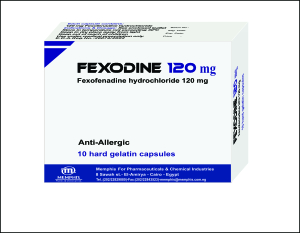TRADE NAME: Fexodine 120mg capsules GENERIC NAME: Fexofenadine hydrochloride COMPOSITION: Each capsule contains: Active ingredient: Fexofenadine hydrochloride 120 mg Excipients: Lactose monohydrate, Cros carmellose sodium (Ac-di-sol), Microcrystalline cellulose (Avicel PH101), Talc, Magnesium stearate. PHARMACEUTICAL FORM: Capsules. PHARMACOLOGICAL ACTION: PHARMACODYNAMICS: Pharmacotherapeutic group: orally active non-sedating H1-receptor antagonist. Mechanism of action Fexofenadine hydrochloride is the synthetic hydrochloride salt of fexofenadine, the carboxylic acid metabolite of terfenadine (Teldane). It is an orally active non-sedating H1-receptor antagonist and is effective for the relief of symptoms associated with seasonal allergic rhinitis (sneezing, rhinorrhea, pruritus and lacrimation). Fexofenadine is the major metabolite of terfenadine in man and is largely responsible for the antihistaminic effect following the administration of terfenadine. PHARMACOKINETICS: Absorption Fexofenadine hydrochloride is rapidly absorbed following oral administration. Tmax occurred approximately 1-3 hours postdose. The mean Cmax was approximately 142ng/mL following the administration of a single 60mg dose, approximately 289ng/mL following a single 120mg dose and approximately 494ng/mL following a single 180mg dose. The absolute bioavailability following fexofenadine hydrochloride administration is calculated to be 33%. Absorption of fexofenadine is not significantly altered by food. Distribution Fexofenadine is 60-75% bound to plasma proteins in healthy subjects. Biotransformation Fexofenadine undergoes negligible metabolism. Elimination Following a single 60mg oral dose, 80% and 11.5% of total fexofenadine dose was excreted in the faeces and urine respectively. Following multiple dosing, fexofenadine has a mean terminal elimination half-life of 11-16 hours. The major route of elimination is believed to be biliary excretion while up to 10% of the ingested dose is excreted unchanged through the urine. Linearity The single and multiple dose pharmacokinetics of fexofenadine are linear between 20mg and 120mg doses. A dose of 240mg twice daily produced slightly greater than proportional increase (8.8%) in steady state area under the curve. In 7-12 year old allergic rhinitis patients, cross study comparisons indicated that fexofenadine area under the curve following oral administration of a 60mg dose was 56% greater compared to healthy adult subjects given the same dose. Additionally, fexofenadine clearance in paediatric patients has been determined to be approximately 40% lower than in adults. In view of this a dose of 30mg twice daily in paediatric patients will provide plasma fexofenadine concentration that are comparable to those associated with efficacy in adults. Administration of a 15 mg dose of fexofenadine to paediatric subjects aged 6 to 23 months, and of a 30 mg dose to paediatric subjects 2 to 11 years, produced exposures comparable to those seen with a dosage of 60 mg administered to adults. The pharmacokinetics of fexofenadine in seasonal allergic rhinitis patients are similar to those in healthy subjects. One study indicated that females may be exposed to higher plasma levels than males, however, there was no indication of any difference in safety or efficacy. Elderly patients, patients with hepatic impairment and patients with cardiac disease exposed to fexofenadine by administration of terfenadine showed no statistically significant differences in pharmacokinetic parameters for fexofenadine compared to healthy individuals. Although peak plasma level and half-life were increased 68% and 15% respectively in elderly patients and 54% and 19% respectively in patients with renal disease regardless of disease severity, these levels are within the range of plasma levels shown to be well tolerated in adequate and well controlled safety and efficacy trials. INDICATIONS: Relief of symptoms associated with seasonal allergic rhinitis and allergic rhinitis in adults and Children aged 12 years or older. Relief of symptoms of urticaria in adults and Children aged 12 years or older. DOSAGE AND ADMINISTRATION: Adults and Children aged 12 years or older Allergic Rhinitis: 60 mg twice daily, when required. Seasonal Allergic Rhinitis: 120 mg or 180 mg once daily, when required. Urticaria: 180 mg once daily, when required. Special risk groups Studies in special risk groups (elderly, renally or hepatically impaired patients) indicate that it is not necessary to adjust the dose of fexofenadine hydrochloride in these patients. CONTRAINDICATIONS: FEXODINE is contraindicated in patients with a known hypersensitivity to fexofenadine or any of its ingredients. WARNINGS AND PRECAUTIONS: Important information about some of the ingredients in FEXODINE 120mg capsule. FEXODINE contains lactose. Patients with rare hereditary problems of galactose intolerance, the Lapp lactase deficiency or glucose-galactose malabsorption should not take this medicine. Studies in the elderly, patients with hepatic impairment and patients with cardiac disease exposed to fexofenadine through administration of terfenadine showed no statistically significant differences in pharmacokinetic parameters for fexofenadine when compared to those pharmacokinetic parameters in healthy individuals. As with most new drugs there is only limited data in the elderly and renally or hepatically impaired patients. Fexofenadine hydrochloride should be administered with care in these special groups.
